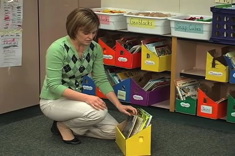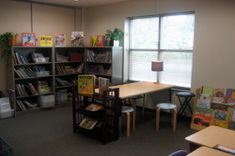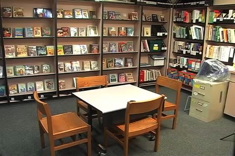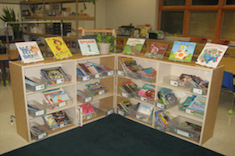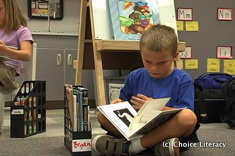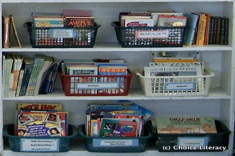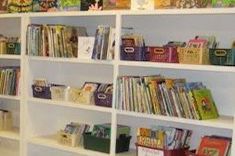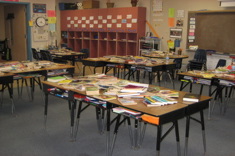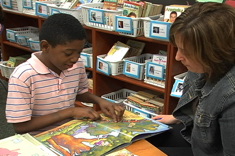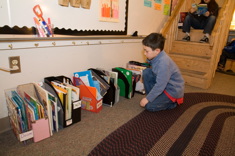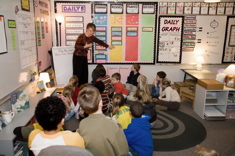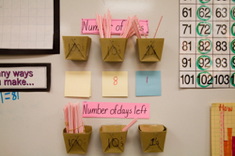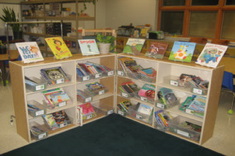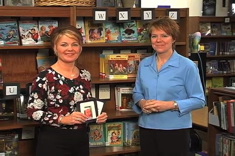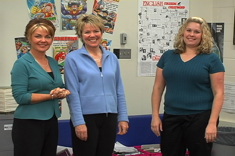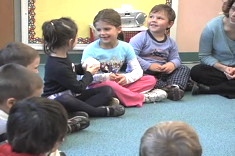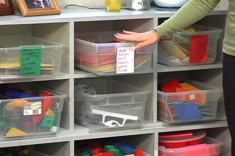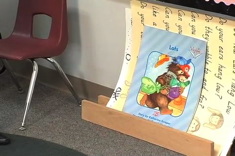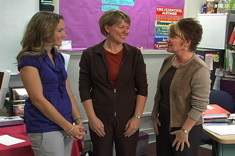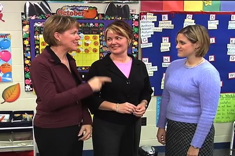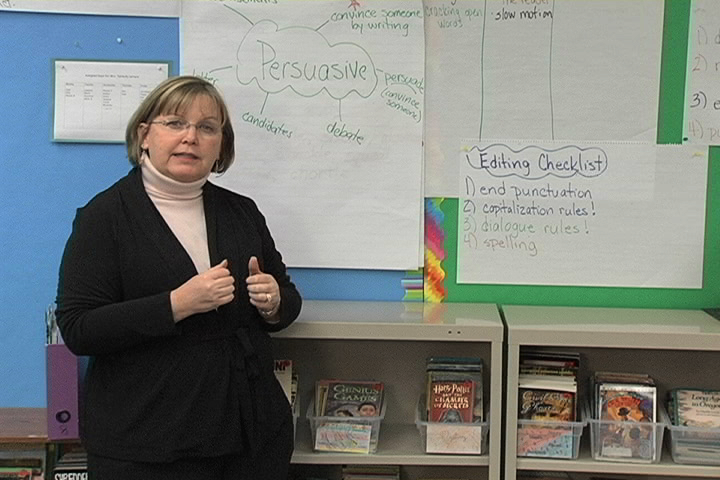Classroom Design
There's been a remarkable amount of brain research demonstrating how crucial environments are for learning. Cozy, well-lit and well-organized spaces are essential for literacy learners of any age. The constraints teachers face in designing and organizing their classrooms are enormous -- from irritated fire marshals to fear of lice infestations, with limited budgets always at the forefront. You'll be inspired by these beautiful classrooms, created by teachers who manage to design spaces any reader or writer would love.
Latest Content
Redesigning a Classroom: Putting Students First (and Technology in Its Place)
Mandy Robek faces the challenge of creating a warm and inviting classroom environment that still includes some cold, hard computers for student use.
You Never Know What You’re Going To Get
When students help us organize materials, we are often pleasantly surprised at the results.
Reorganizing Books in the Reading Support Classroom
Katie DiCesare helps her mom, a reading support teacher, reorganize her materials to better serve students.
Favorite Spaces (Part 1)
What's your favorite literacy spot this year in your classroom? We asked our friends and contributors at Choice Literacy to send in pictures with brief descriptions for this two-part feature. Here is a peek in the classrooms of Donalyn Miller, Julie Johnson, Mary Lee Hahn, Katie DiCesare, and Mandy Robek.
Favorite Spaces (Part 2)
We asked a few Choice Literacy contributors to share their favorite classroom spaces with readers. We hope you'll get some ideas for your own classroom design from these amazing teachers. This is the second installment in a two-part series.
Bookroom Makeover in the Midst
In this video tour, Jessica Ardela and Josie Stewart talk about the renovations in progress in bookrooms at their school in Dublin, Ohio. The goal is to make it easier for students and teachers to access the texts they need, as well as create spaces for professional conversations among teachers.
What Messages Do We Give Students with Our Classroom Library Design?
Franki Sibberson describes how the topics and arrangements of baskets in the classroom library give strong messages about reading to students.
Book Boxes – Voices from the Classroom
How do you organize and use book boxes? Every teacher has their own twist on the answer to this question. Choice Literacy contributors give examples from grades 1-5 of how they use book boxes and bags with their students.
Changing the Learning Landscape: Organizing My 6th Grade Classroom (PHOTO ESSAY)
Ann Marie Corgill switches from a 1st to 6th grade classroom, and finds herself immersed in rethinking the “learning landscape” as she unpacks boxes and sets up her classroom. While the room looks a little different, the principles for classroom design are the same. She shares her process in this photo essay.
Out of the Closet and into the Classroom: Bookroom Management Tips for Literacy Coaches
Is your system for sharing books from a school bookroom or literacy closet working well? Shari Frost provides 10 practical tips for getting the best use out of shared literacy resources.
A Workshop Model in the Library: Time for More Than Book Checkout
Franki Sibberson shares ideas for library browsing baskets, as well as ways to integrate minilessons into the school library routine.
A Tornado of Books
By upending the classroom library and asking students to sort and reorganize it, Karen Terlecky gets insight every year into the ways students categorize texts, as well as their emerging understanding of genre.
Student Independence and Ownership in the Library
The “status of the class” form is a tool used by many teachers in reading and writing workshops to chart student plans daily. As Franki Sibberson tests out a status form in the school library, she discovers it has more value than she realized.
Tight Spaces Part I: Maximizing Room for Literacy Learning (PHOTO ESSAY)
The Sisters (Gail Boushey and Joan Moser) have some ingenious tips for freeing up traffic paths and clustering literacy work areas.
Tight Spaces Part II: Design Photo Essay Series
The Sisters' design tips on tight classroom spaces cover walls and creative storage in this photo essay.
Warm It Up: Lighting a Classroom for Literacy (PHOTO ESSAY)
Here are a few suggestions and quick tips for a lighting redesign from The Sisters (Joan Moser and Gail Boushey).
Meeting Areas (Design Photo Essay Series)
Design tips from “The Sisters” (Gail Boushey and Joan Moser) for beautiful and functional meeting areas.
Wall Displays (PHOTO ESSAY)
The Sisters (Joan Moser and Gail Boushey) contribute a photo essay on design tips for wall displays.
Organizing Book Bins: Letting Kids Help and Plan
Katie DiCesare writes about how children can be enlisted to help in creating and organizing book bins in libraries. But in Katie's classroom, the process of matching books to children begins with "My Stack" – her pile of books that changes daily, linking individual children and texts of interest.
Got Space?
Jennifer Allen gets creative with space for displays in her literacy coaching work.
Bookroom Tours Part III
In this six-minute video, The Sisters (Gail Boushey and Joan Moser) give a tour of a “choice” bookroom. Unlike many bookrooms organized by level and maintained by teachers, this room of chapter books is organized by author.
Middle School Classroom Makeover Part I
In this first of a three-part video series, “The Sisters” (Gail Boushey and Joan Moser) help 7th grade teacher Erin declutter and rearrange her classroom.
Morning Meeting in Kindergarten
Danielle French leads her kindergarten students in Waterville, Maine, during morning meeting. After the meeting, Danielle talks with “The Sisters” (Gail Boushey and Joan Moser) about the value of this daily routine.
Organizing for Independence: From Cubbies to Social Groups
In this brief video, Joan Moser talks about how she organizes student materials in "social groups" to avoid the use of desks or cubbies in her classroom.
Big Books and Charts Organizer
In this two-minute video, Joan Moser shares a simple tool teachers can create for their classrooms to keep Big Books, charts, and laminated large materials organized.
Makeover for the Teacher Desk Area
"The Sisters" (Gail Boushey and Joan Moser) work with Sarah Thibault and friends in Maine to makeover the teacher desk area in her 4th grade classroom.
3rd Grade Meeting Area Makeover
Are your meeting area wall displays too cluttered? "The Sisters" (Gail Boushey and Joan Moser) help a 3rd grade teacher rethink her wall displays and meeting area in this ten-minute video.
1st Grade Room Tour with Katie DiCesare
In this video tour of her 1st grade classroom, Katie DiCesare highlights the many areas of the room used to support literacy, including the classroom library and wall displays.
5th Grade Room Tour
Karen Terlecky’s classroom tour focuses on the anchor charts and wall displays she uses to promote literacy with her 5th grade students.
Kindergarten Room Tour
In this room tour, Maureen Knostman of Dublin, Ohio shares literacy areas in her kindergarten classroom.
Browse Content By
Type
Category
- Assessment Tools
- Big Fresh Archives
- Booklists
- Choice Numeracy
- Classroom Design
- Common Core
- Community Building
- Conferring
- Content Literacy
- Digital Literacy
- English Language Learners
- Equity
- Family Relations
- Free Samples
- Guiding Groups
- Leadership
- Literacy Coaches
- Mentor Texts
- Minilessons
- New Teacher Mentors
- Podcasts
- Poetry
- Quote Collections
- Reading Strategies
- Self Care
- Struggling and Striving Learners
- Talking and Listening
- Teacher Study Groups
- Teaching Reading
- Teaching Writing
- Word Study and Vocabulary
Author
- Melissa Quimby
- Nawal Qarooni
- Gwen Blumberg
- Julie Cox
- The Lead Learners
- Hannah Tills
- Josie Stewart
- Ruth Metcalfe
- Mallory Messenger
- Becca Burk
- Jodie Bailey
- Vivian Chen
- Mary Brower
- Tiffany Abbott Fuller
- Stephanie Affinito
- Ruth Ayres
- Leigh Anne Eck
- Heather Fisher
- Shari Frost
- Julie Johnson
- Suzy Kaback
- Gigi McAllister
- Shirl McPhillips
- Melanie Meehan
- Cathy Mere
- Debbie Miller
- Tara Barnett and Kate Mills
- Tammy Mulligan
- Dana Murphy
- Bitsy Parks
- David Pittman
- Brenda Power
- Heather Rader
- Matt Renwick
- Mandy Robek
- Christy Rush-Levine
- Gretchen Schroeder
- Jen Schwanke
- Brian Sepe
- Katherine Sokolowski
- Stella Villalba
- Jennifer Vincent
Grade Level
Choice Literacy Membership
Articles
Get full access to all Choice Literacy article content
Videos
Get full access to all Choice Literacy video content
Courses
Access Choice Literacy course curriculum and training



